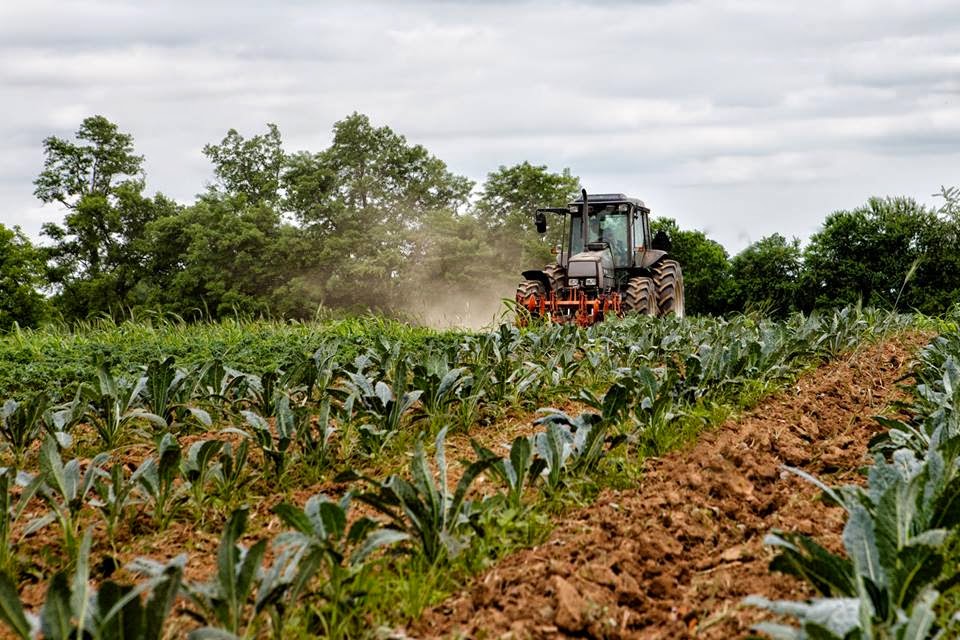Share items may vary depending on your share size and harvest day. Each share may not have every item listed below.
Asparagus
Red Beets with Tops – organic
Find a handful of the first beet harvest of the season. Remove the beet root from the stems and use the beet greens either raw in a fresh green salad, or cook with your mixed green bunch. The red color can be a little intense, but know that you are consuming a blood tonic that is good for anemia, your heart and circulation. Beets also contain notable amounts of calcium, iron, magnesium, and phosphorus. Refrigerate for storage; the beet root will keep for several weeks, the greens should be used within a few days. Several recipes can be found by searching beets on this online web blog.
Greens: Lacinato Kale, Mustard, Turnip, Flat Leaf Kale – organicWe decreased the frequency of these mixed green bunches last season and several of you really missed them in your shares. We won’t be overloading you with hearty greens this year, but this week is prime time for their harvest – before the heat limits the growing season for spicy greens like mustard and turnip. The kales are much milder and will continue to produce this summer. Refrigerated, heavy greens will keep well for you for 7-9 days.
There are many choices for preparation:
(1) the old KY standard recipes of simmering on the back of the stove for a couple of hours seasoning with bacon grease, peppers, or an onion for extra flavor;
(2) steam until wilted and serve sprinkled with vinegar;
(3) sauté with garlic or onion until tender.
With any recipe, remove any thick stems by tearing the stalks out of the leaves. And be sure to cook your greens long enough to ensure they are cooked through and tender.
Fresh greens are one of the healthiest items in your share this time of year. Kale contains calcium, iron, Vits. A and C, and is said to offer protection from both macular degeneration and colon cancer. Mustard greens are a superior anticancer veggie – the strong flavor will mellow when the greens are cooked. Turnip greens, like many other vegetables, are high in calcium.
Fresh Herb, Cilantro – organic
You can use this fresh cilantro to make a vinaigrette (find a popular recipe below), add to homemade pico de gallo or salsa, cook with dried beans, and add to any pasta recipe. Store refrigerated.
Lettuce Heads - organic
Another week with healthy heads of lettuce for you. The heat and high temperatures may push the June lettuces to flower prematurely and become unhar-vestable, so don’t worry - you won’t be having this much each week. Share with your friends if you have too much to enjoy, and find two new, yummy recipes below using fresh lettuces. Varieties in your share this week include Bronze Arrow, Emerald Oak, and the fluffy red in the larger shares is a Red Crisphead variety. Storage and refreshing tips in Week 2 newsletter.
Sugar Snap Peas – organic
You eat the entire pod and peas with this type. Break the ends and if a string has developed, pull it off from end to end. We grow stringless varieties, but sometimes the pea pods will produce a string anyway. Steam or sauté/stir fry, and try not to overcook or the texture can become a little mushy.
Store refrigerated in a closed container and use fairly soon as they will lose crispness over time. Sugar snap peas can be frozen after blanching.
Strawberries – organic
We see very few new flowers on the strawberry plants. The amount of berries ready to harvest are also decreasing each day, so one of our favorite fruits is on its way out-of-season. We harvest as ripe as we can to ensure you get full flavor – refrigerate if needed – and if you have any extra, cut off the stem and store in the freezer to enjoy later on.
Lemon or Cinnamon Basil - organic
Use your sprig of scented basil in salads, teas or a dressing. We needed to pinch our plants to encourage better growth, so we included the tops in your share today.
Broccoli – organic
Today’s small broccoli harvest is from the first heads that are beginning to open early due to the heat this past weekend. The full crop is not expected to be ready to harvest for another week or so – we’ll see how many 85°days and how many cloudy days we get during this next week. That will determine how balanced and predictable our harvest will go.
Recipes to Enjoy . . .
Lettuce Soup
Makes 4 servings. Our thanks to a friend of the farm for sharing this Emeril Lagasse recipe. Don’t let the name fool you into conjuring up a skeptical image. At a farm lunch last week, most folks thought it was spinach soup and everyone really enjoyed it.
2 T olive oil
1 C sliced onion
1 tsp chopped garlic
1 T chopped parsley
1 T chopped chives
2 tsp chopped tarragon
2 heads lettuce, leaves torn
3 C chicken stock
½ C heavy cream or evaporated milk
½ tsp salt
¼ tsp pepper
chive blossoms, for garnishing, optional
Heat olive oil over medium-low heat in a large saucepan. When hot, add the onions and garlic and cook until the onion is translucent, about 4 minutes. Add the parsley, chives, tarragon and lettuce and stir until the lettuce is completely wilted, about 3 minutes. Add the chicken stock and simmer, uncovered for 20 minutes. When ready to serve, process the soup, in batches, taking care since the soup is hot, then return to a clean saucepan. Stir in the heavy cream or evaporated milk and the salt and pepper and simmer another 5 minutes or until heated through. Adjust seasonings, if necessary, and serve immediately, garnished with fresh herbs and chive blossoms, if desired.
Cilantro Vinaigrette
From Cooking with Nora. This can be used over a green salad, for roasted vegetables, or as a marinade for items for the grill. If you have any green garlic remaining in your refrigerator, this recipe is a great use. You may need to adjust the amounts below to fit your portion size if you have a mini share.
1/3 C cilantro leaves, tightly packed
2 shallots or 1 small onion, peeled
2 cloves garlic, peeled
1 small green jalapeno pepper (optional)
1 inch piece of fresh ginger, peeled and sliced
1 T tamari
1 T rice wine vinegar
3 T water
3 T oil
Preheat oven to 400 degrees. Put garlic and onion in non-reactive baking dish. Add 1 tsp olive oil and season with salt and pepper. Cover with foil and roast for 30-40 minutes until soft. After roasted, put all ingredients in a blender. Puree until smooth.
Steak and Vegetable Soup
Our thanks to a long-time CSA member who shared this soup recipe. The original was in Gourmet Magazine, and he reports it is one of his favorite ways to use his kale greens. Serves 2.
½ lb. boneless top loin steak (New York strip or shell), trimmed of excess fat and cut into 1-inch pieces
1 T olive oil
1 medium onion, thinly sliced
2 chopped carrots, thinly sliced
2 celery ribs, halved lengthwise and thinly sliced crosswise
3 garlic cloves, finely chopped
2 tsp finely chopped thyme
salt and black pepper
½ lb. Yukon Gold potatoes, peeled and cut into ½ inch cubes
1 C diced tomatoes with some juice (from a 14-oz can)
1 ¾ C beef broth
2 ¼ C water
2 C chopped kale leaves
1 C medium egg noodles, cooked
Pat steak dry. Heat oil in a 4 to 5 qt heavy pot over medium-high heat until it shimmers. Cook steak until browned on all sides and medium-rare, about 3 minutes, then transfer to a plate.
Cook onion, carrots, celery, garlic, thyme, ½ tsp salt, and ¼ tsp pepper in pot over medium heat, stirring occasionally, until softened but not browned, about 8 minutes.
Stir in potatoes, tomatoes with juice, broth, and water and simmer, partially covered, until potatoes are tender, about 15 minutes. Stir in kale and cook, uncovered, until tender, about 5 minutes. Stir in steak with meat juices, cooked noodles, and salt and pepper to taste.


